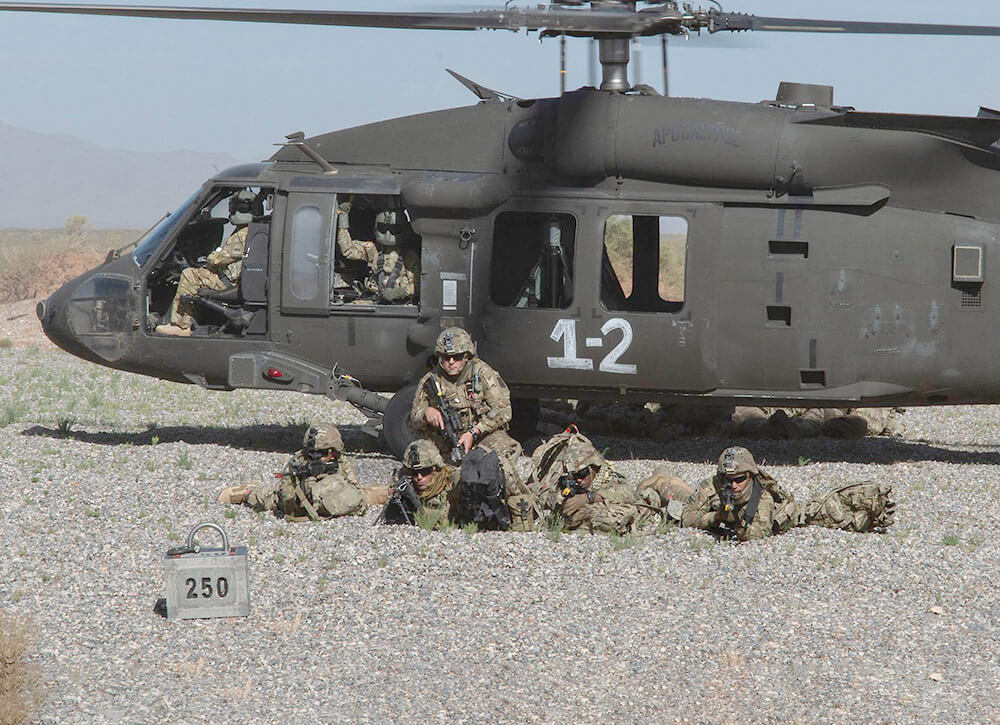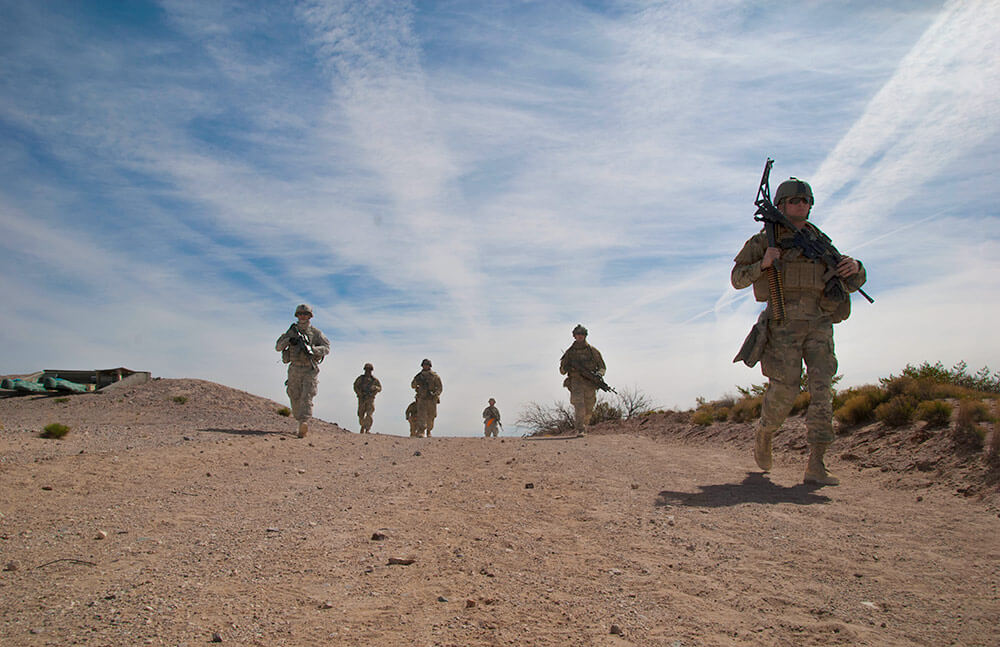Arizona’s 1-158th Infantry Regiment Prepares to Join the Fight in the Middle East
Four hundred Soldiers of 1st Battalion, 158th Infantry Regiment “Bushmasters,” Arizona Army National Guard, spent 45 days this past summer at Fort Bliss, Texas, conducting premobilization training and validation in advance of a one-year deployment to Kuwait.

While the Soldiers of the 1-158th did not have the exact details of the mission ahead, they knew it would involve providing security to naval bases and convoys in the regions in and around Kuwait.
“We’ll be the primary security detail on convoy operations, base defense and security force [SECFOR] missions,” explained SFC Pedro Villanez, commander of the 1-158th’s 1st Platoon, B Company. “On a day-to-day basis, it would be the securing of the patrol that we were going to run, whether it’s mounted on vehicles such as M1151 HMMWVs [high mobility multipurpose wheeled vehicles], or MaxxPros or M-ATVs [Mine Resistant Ambush Protected-All Terrain Vehicles] that we have.”

Training validations for the light infantry unit encompassed roll-over training for the M-ATVs and shooting range qualifications, including small arms ranges and crew-served weapons ranges. The unit was also tested on medical validation, both personnel physical exams along with a Combat Life Saver Course. Training validations also included Sexual Harassment/Assault Response and Prevention validation, extensive communications training, driver training, classes on Blue Force Tracker and Company Intelligence Support Team training.
Also included was a 10-day course on Base Expeditionary Targeting and Surveillance Systems – Combined (BETSS-C). The BETSS-C is a networked sensor package focusing on surveillance, detection, security monitoring and targeting.

“BETSS-C is a new concept to me,” said CPT James Roe, Headquarters and Headquarters Company commander for the 1-158th. “What’s great about [BETSS-C] is that it results in certifications for our Soldiers that won’t time out after the deployment. They can carry [the certifications] for the rest of their careers.”
Planning well ahead of the deployment, Arizona National Guard leaders worked to ensure the 1-158th had plenty of advance training and opportunities to begin their validation as a unit before arriving at Fort Bliss.
“When we hit the ground, we were well into the 80 to 90 percent across the board on [completing] all of the validation requirements,” said 1-158th Infantry Regiment Operations Officer MAJ Brian Gaume. “That allowed us time to conduct quite a bit of extra training.”

MAJ Gaume attributed the unit’s efficiency in validation to Arizona’s designated State mobilization team, which focuses on preparing Arizona Guard units for validation in advance of arrival to the premobilization site.
“They knew all the validation requirements that we’d be asked of once we got to mobilization training,” he explained. “They ensured that we got good quality training on those tasks before we got here.”

The Soldiers had three opportunities across the previous year to begin validation before premobilization. The battalion had three weeks of annual training in March of this year. There, the Soldiers completed extensive weapons qualifications, including personal weapons and validation on the M249 and M240 Bravo. In May, they conducted an enhanced nine-day drill and in June they completed the State mobilization training. These separate, staggered opportunities allowed the unit multiple passes to get every Soldier 100 percent qualified.
That, in turn, gave the unit extra time to conduct a high-intensity air assault exercise while at Fort Bliss. With the help of the 501st Assault Helicopter Battalion, 250 of the 1-158th’s Soldiers trained with a total of six aircraft – four UH60 Black Hawks that moved personnel and two AH64 Apaches that provided overwatch.

“[The training] went great. We successfully completed the air assault mission and the infantry’s primary mission, which was to set up blocking positions,” explained CSM Daniel Figueroa, Special Operations Team, 1-158th Infantry Regiment. “We’re not air assault-qualified, but we do conduct air assault missions using aviation assets.”
Back in January of this year, the 1-158th conducted an air assault training mission with Arizona’s State aviation unit. It was very similar to their Fort Bliss exercise, MAJ Gaume said. Four UH60s were moving in personnel and two Black Hawks were on station awaiting call-for-fire. The unit also participated in air assault training during last year’s Exercise Northern Strike.
“We’re no strangers to air assault missions, no strangers to getting in and working with our aviation brethren,” MAJ Gaume noted.

The Arizona Soldiers put the additional training time at Fort Bliss to good use. According to CSM Figueroa, this was a first deployment for about 70 percent of the unit, and its leadership wanted to ensure each member was completely mentally and physically prepared for their deployment.
“I think across the board, we’re really faring quite well,” CPT Roe remarked. “We’re ready to move on to the next phase.”
“First and foremost, this mission will be accomplished no matter what or how long it takes,” added CSM Figueroa.
During the unit’s last deployment to Afghanistan in 2007–2008, two Soldiers made the ultimate sacrifice. Killed in action were SSG Charles Browning and PFC Mykel Miller.

“At the time, I was assigned to Bravo Company and 1st Platoon lost SSG Browning and my Platoon – 3rd Platoon – lost PFC Mykel Miller,” recalled SGT Alejandro Morga, commander of 1st Squadron, 3rd Platoon, Charlie Company, 1st Battalion, 158th Infantry Regiment.
He said he has grown as a man and a leader since joining the unit. For SGT Morga, the big picture is not only the larger strategy and logistics of operations. He is focused on his Soldiers and making sure they are taken care of and squared away. He wants them to accomplish the mission and wants to ensure that they can come home to talk about it.

“I’ve got to focus on ensuring my Soldiers are ready for whatever mission the battalion is handed, whatever mission Charlie Company gets chosen to do. Whether it’s staying in Kuwait or pushing forward into another country, I need to ensure the troops are ready with their military abilities and their mental, physical and emotional well-being,” he explained.
“I expect the best out of my Soldiers and they should expect the best out of me as well, [because] every deployment is an engagement,” said SFC Villanez. “Whether it’s combat arms engagement or a person-to-person engagement, they’re all important. Having a face-to-face with someone is an engagement and you can win a battle just by talking to someone. On the other hand, if we have to close with and destroy the enemy, we are trained for that and the men will be ready.”
Sage Wisdom from a Bushmaster: SGT Morga’s Three Keys to Life in the Army National Guard
This is the “us” Army:
“We are a team and we are stronger as a team, both downrange and back home.”
The Army was here before us. The Army is here with us. And the Army will be here after us:
“Consider how we influence [others] during our time in the Army – how we leave our legacy behind with the Soldiers who carry on your leadership traits. Just because you get out, do not think you have not left a lasting impact on the uniform.”
Don’t ever think you have to fight alone:
“I would say, when you come home, know that there is someone out there who has your six 24/7, 365. You can call them up and they’ll round up a QRF [quick reaction force] and get help to you. Even people that have not been downrange are affected by post-traumatic stress in ways that are seen stateside. So when you need help, ask for it. Nobody’s going to look at you like you are weak. I tell people all the time – the strongest thing you can do is ask for help.”
BY STAFF WRITER Matthew Liptak


